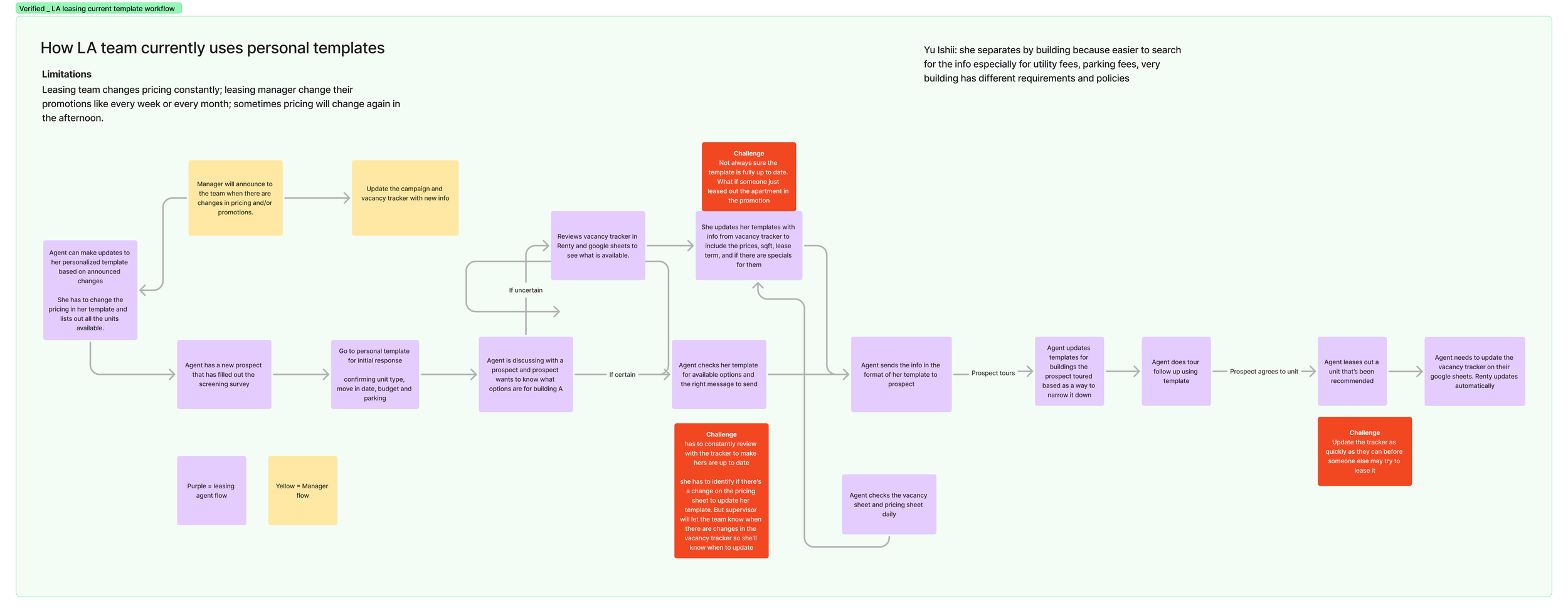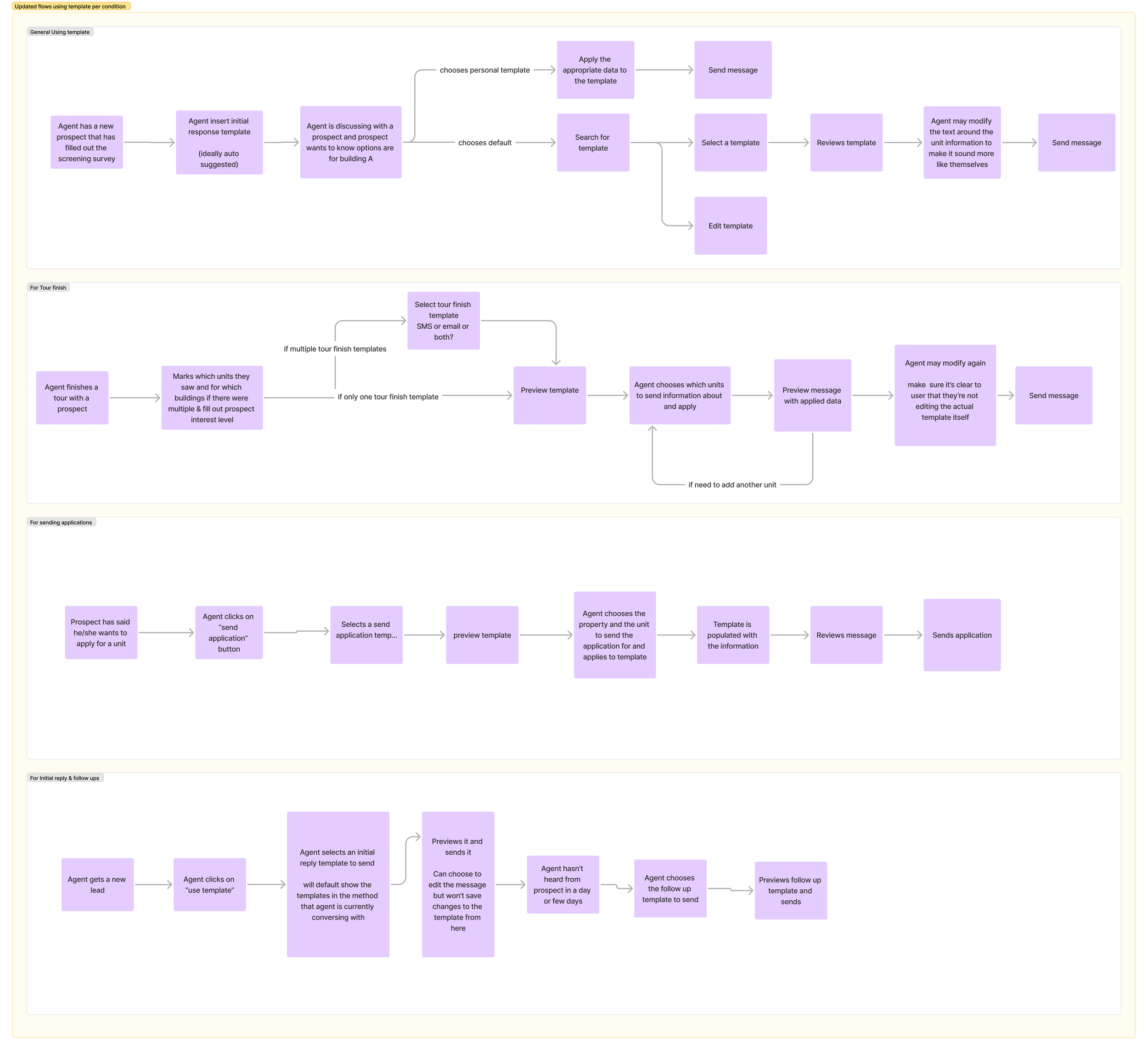Customized templates
Enhance communication efficiency for property management leasing team
Project overview
Tripalink is a property management firm based with property in Los Angeles, Seattle, Chicago, and other regions. Renty is an internal software solution created to support the operations team consisting of leasing managers, leasing agents, and marketing, and property managers to enable the team to communicate with potential prospects who want to rent one of our units.
Our design team does iterative improvements to the Renty product based on the operations team feedback in order to continue making their workflow as efficient and streamlined as possible. All improvements made are to enable the leasing team effectively communicate with their prospects, book more tours, and eventually increase the lease conversion.
Project Timeline: End of September 2024 - November 2024
My Role & Contributions
Zero to One from feature inception to development
Extensive research by interviewing leasing teams across multiple regions to deeply understand problem space
Collaborate with product manager and engineers to shape feature requirements, aligning on scope and feasibility.
Responsible for all user flows, wireframes, & prototypes
Providing specifications, designs QA, and hands on support to maintain design integrity.
Problem discovery and Research
UNDERSTANDing the scale of the problem
I first had to uncover and see if templates not being accessible in Renty was a large scale or minor issue. I had previously only heard feedback from one leasing agent about needing her own template available in the application. Therefore, I needed to do more extensive research with multiple teams across multiple regions to gather more data.
Interviews with 5 regions: Philadelphia, Pittsburgh, Chicago, LA, Seattle
After extensive interviews with leasing agents and their managers, and reviewing conversations that they have with their prospects, I discovered that most leasing agents across in our largest 2 regions needed to use templates and had already created their own to communicate with prospects. Their current solution now is to continuously copy and paste from Google docs into their chat box in Renty.
challenges of current solution
Annoying to bounce back and forth between applications: users would have to copy and paste from google docs into Renty. Also difficult to manage templates since they’re housed in a different location.
Cannot easily replace data in templates: Many conversations leasing agents have with prospects are around recommending different units and home with different pricing, square footage, lease terms, etc. This data they have to constantly replace manually and is time consuming.
IDENTIFY & VALIDATE CURRENT FLOW
Below is the current user flow I created regarding how the largest operations teams in Tripalink use templates. Identifying the current flow will influence how the new flow of working with customized templates can be done in the Renty application. I validated with their teams the accuracy of these diagrams and it was approved.


Designing new user flow
Created and validated vision for how this feature would work in the existing Renty product with the product team and operations team. The overall vision includes how leasing managers would create templates for their employees, how leasing agents can create templates for themselves, and how each person would use the template to communicate with prospects.
What makes these templates unique compared to ones from google docs is they’re not only created from text, but also would include variables for data that could change such as property unit, property address, rent, lease terms, square footages, etc. Manually changing the data each time agents would use the template was one of the largest pain points they expressed that they had.
long term vision
The long term vision I created includes the following:
Share templates across teams and team members
Data blocks: ability to group multiple variables together to form a data block
Ability to suggest message content depending on scenario. This was a suggestion because many of our users were non native English speakers so it was difficult to come up with ad-hoc content that would elicit positive responses from the American prospects.
The items above had to be descoped in order for engineering to complete the feature within two 2-week sprint cycles.
minimum viable product
Separated the flows into the 4 main use cases in the product that would use templates: general usage, completing a tour finish flow, sending applications, and for initial replies and follow ups with prospects.
Each flow has a similar pattern with the exception of tour finish flow and send application flow where a template will already be selected by default. These flows have a default template selected because after observing how the operations team talk with prospects, I saw that they always use a template that they already created to send the summary of the tour to the prospects.
Instead of full data blocks that would group multiple variables together, the MVP version is more simple to contain single variables that can be inserted into the template.
Every flow is validated with the product team and operations teams.
Ideations
Now that I was able to create the user journeys and have them validated, I began the ideation process where there were at least 5 iterations. The Renty application uses components from Ant Design.
Goals for the design - using templates
Easy to select the desired template to use
Apply data to any variables inside the template
Goals for the design - managing templates
Intuitive way to create, duplicate, delete templates
Create a way for users to organize their templates
Below is an example of 2 detailed flows: using template and managing templates


Test designs & write specs
After multiple iterations, I wanted to test the potential flows to get feedback on which direction to proceed. I narrowed iterations down to two after collecting feedback from the design team and with the product team. Afterwards, I tested the top 2 designs with 5 members of the operations team across the two largest regions.
Below is an example of the 2 iterations for applying data to the template


Prototype of final solution
After final testing with the operations teams, it was validated that one solution was better than the other so I proceeded to write up the specifications for the designs and created the final prototype below.
USING TEMPLATES flow
managing templates
Where is the project now?
Development of this feature was paused after designs were completed, but has resumed. After development, we will add Pendo funnels to understand usage metrics and to monitor if there are any significant drop off points. Based on this feedback, we will modify the designs as necessary.





